December 8, 2017
Air Date: December 8, 2017
FULL SHOW
SEGMENTS

Federal Land Conservation Under Fire
View the page for this story
Despite the skepticism of legal scholars, the Trump Administration claims it can reverse national monument land protections by drastically shrinking the Bears Ears and Grand-Staircase Escalante monuments in Utah. Conservation and Native American groups have sued, saying only Congress can change National Monuments and not the President. Living on Earth Host Steve Curwood spoke with Wilderness Society President Jamie Williams about this decision, and the broader implications of opening federal public lands for commerce. (07:18)

Beyond The Headlines
/ Peter DykstraView the page for this story
This week in Beyond the Headlines, Peter Dykstra and host Steve Curwood discuss a convicted felon’s campaign for the U.S. Senate and an Obama-era EPA coal cleanup rule that’s bitten the dust. For the history lesson, the duo recalls the Kyoto Protocol, one of the first international efforts to limit greenhouse gas emissions. (03:58)

Feds Move to Dismiss Youth Climate Suit
View the page for this story
A group of 21 youths is suing the US government for its failure to protect their future by preventing harmful global warming impacts. But the Trump administration says the case should be dismissed. Oral arguments before the 9th Circuit Court of Appeals on December 11th will help its judges decide whether the case should move ahead to trial. Vermont Law School Professor Pat Parenteau takes host Steve Curwood through the arguments on both sides, and what could happen next. (12:43)

Dog Lovers Live Longer
View the page for this story
Having a dog in your household can help you feel loved and valued, and new research from Sweden shows that there can be measurable cardiovascular health benefits as well. Prof. Tove Fall from Uppsala University in Sweden tells host Steve Curwood about her research published in the journal Scientific Reports and why single people appear to benefit most. (07:07)

The Inner Lives of Fish
View the page for this story
Aquatic creatures seem so different from us it is easy to think they don’t think. But Culum Brown, who studies fish cognition and teaches at Macquarie University in Sydney, Australia, says some fish are actually pretty smart, exhibiting complex social behaviors, navigation skills, and even tool use. Prof. Brown tells host Steve Curwood how pharmaceutical companies are using zebra fish to develop antidepressants, and how we can keep the fish in our home aquariums happy and healthy. (13:04)

A Dinner for Fish
/ Mark Seth LenderView the page for this story
Peering into the Sea of Cortez, Living on Earth’s Resident Explorer Mark Seth Lender notices a trio of fearsome Wahoo that may be sizing him up for lunch. (02:23)
Show Credits and Funders
Show Transcript
HOST: Steve Curwood
GUESTS: Jamie Williams, Pat Parenteau, Tove Fall, Culum Brown
REPORTERS: Peter Dykstra, Mark Seth Lender
[THEME]
CURWOOD: From Public Radio International, this is Living on Earth.
[THEME]
CURWOOD: I'm Steve Curwood. President Trump opens up some National Monuments for commercial mining and development.
WILLIAMS: This action is the largest rollback of land protection in the history of the United States and what the Trump administration has done is reflective of a much larger agenda to sell out our public lands to the highest bidder for short-term gain.
CURWOOD: And it ignores the millions of Americans who demanded more public land protection. Also, fish have feelings and can use tools.
BROWN: Of course fish don't have hands, but they're very well-known for manipulating water, for example. So Archerfish can basically generate a water-pistol. They sit at the surface of the water and shoot insects above the surface of the water, and the insects fall to the surface of the water and they grab them as they fall down. And their marksman skills are second to none.
CURWOOD: That and more, this week on Living on Earth. Stick around.
[NEWSBREAK MUSIC: Boards Of Canada “Zoetrope” from “In A Beautiful Place Out In The Country”, Warp Records 2000]
[THEME]
Federal Land Conservation Under Fire

Valley of the Gods in Bears Ears National Monument. (Photo: John Fowler, Flickr CC BY 2.0)
CURWOOD: From PRI and the Jennifer and Ted Stanley Studios at the University of Massachusetts Boston, this is Living on Earth. I’m Steve Curwood.
Back in 1906 President Teddy Roosevelt used the newly created Antiquities Act to protect from settlers the Devils Tower in Wyoming, made famous in the movie Close Encounters of the Third Kind, by declaring it a National Monument, with rules similar to National Parks. There are now more than a hundred US monuments that safeguard landscapes and key Native American and historic sites, from the Statue of Liberty to the Giant Sequoias to the Misty Fjords in Alaska and even parts of the Grand Canyon.
President Trump recently ordered radical shrinkage of two National Monuments in Utah, Bears Ears and Grand Staircase Escalante, but many legal scholars argue that only Congress can do that.
Joining me now is Jamie Williams. He’s president of the Wilderness Society, which has gone to court to try to block the President’s move. Welcome to Living on Earth.
WILLIAMS: Thank you, Steve.
CURWOOD: So, Jamie, if I understand the argument, if Mr. Trump is allowed to drastically reduce Bears Ears and Grand Staircase, it would set a precedent that would allow any president to, let's say, lease the Statue of Liberty to a tourism promoter like Disney or turn the Giant Sequoias over to loggers or open up Misty Fjord in Alaska to mining for molybdenum.

Grand Staircase-Escalante National Monument. (Photo: Bureau of Land Management, Flickr CC BY 2.0)
WILLIAMS: That's correct. Make no mistake. What the president has done here, has declared open season on the places Americans love by opening them up for mining, drilling, logging, and developing in other ways that would destroy the natural and cultural heritage. This action is the largest rollback of land protection in the history of the United States, and it ignores the millions of Americans who stepped out and were vocal about the need to protect these places. They held a 60-day public comment period on their review of these National Monuments, and close to three million comments came in during that review period. More than 98 percent of those comments said, “Not only should these places be protected and left as they are, but we should protect more National Monuments in this country”. So, what the Trump administration has done is reflective of a much larger agenda that you see with this administration to sell our public lands to the highest bidder for short-term gain.
CURWOOD: What exactly does he want to do to Bears Ears and Grand Staircase Escalante?
WILLIAMS: Well, what President Trump has done is essentially eliminated both of these National Monuments, as we know them. He's shrunk Bears Ears National Monument by more than 85 percent down to just 200,000 acres, to very small fragments of what this incredibly cultural landscape is about. And in the case of the Grand Staircase Escalante, which is essentially a two million acre Monument, he has repositioned three small Monuments that only add up to about half of what the former Monument was but in a fragmented way that will also leave its extraordinary landscapes vulnerable to development.
CURWOOD: So, what's your understanding of what Mr. Trump has in terms of authority under the Antiquities Act, which allows him certainly to create National Monuments. What can he do to shrink or radically alter them?

President Trump’s Executive Order to review the status of all national monuments prompted Interior Secretary Ryan Zinke to travel the country visiting them. Zinke visited Cascade-Siskiyou National Monument in July, standing here along the Pacific Crest Trail. (Photo: Bureau of Land Management, Flickr CC BY 2.0)
WILLIAMS: The Antiquities Act gives a president the authority to create National Monuments but not to revoke them or to shrink them, and so our legal case that we're bringing, as well as the legal case the tribes and other people are bringing to the administration, is that he has overstepped his authority that was given him by the Antiquities Act.
CURWOOD: So, there have been some adjustments of National Monuments over the history of the Antiquities Act. I think back in the '20s Woodrow Wilson made a big change and there been other adjustments, so what's wrong with Mr. Trump doing that now?
WILLIAMS: There have been some adjustments early on, but no adjustments have been made for over 50 years, and none of those early ones were ever challenged, and more important, the power and authority of public lands is vested in Congress, and the Executive Branch only has what's delegated to it through acts of Congress, and so only Congress has the authority to revoke or to modify National Monuments.
CURWOOD: Now, I understand there are special issues around Bears Ears for Native Americans. They played a big role in securing that Monument designation at the end of the Obama administration. In your view, how does this decision infringe on their rights?
WILLIAMS: Well, this decision is a huge step back for Native American rights and their sovereignty and their desire to protect lands that are sacred to them. What was so inspiring about the creation of Bears Ears National Monument a year ago is that it came at the request of five tribes - the Navajo, the Hopi, Zuni, Ute, and Ute Mountain Utes -- that had asked for the protection of their ancestral lands and a nation to nation dialogue, and not only did they get the designation but they also got an agreement to have a seat at the table and collaborative management of these lands. So, that designation was really a beacon of hope for all Native peoples across the country, and that's why this callous action to take that away is being opposed not only vigorously by those tribes but also the National Congress of the American Indians, which is the largest representative organization of Native American governments across the country.
CURWOOD: So, what are the biggest threats facing these Monuments now?

Jamie Williams is President of The Wilderness Society: (Photo: Wilderness Society)
WILLIAMS: Well, what these actions would do in Utah, for these two landscapes in particular, is open them up for coal mining, oil and gas drilling, road development, as well as make them vulnerable to increased looting and desecration of these sacred sites.
And one thing we have not talked about yet is Bears Ears has the richest density of sacred sites and cultural archaeological sites in the country. There's over 100,000 of these sites. We're talking about beautiful rock art that's over 1,000 years old, these masonry cliff dwellings along these sandstone cliffs that are just beautiful. I mean, sacred graves, that all speak to a time of Pueblan cultures over 1,000 years ago, and they're really beloved throughout the country and the world, as evidenced by the millions of visitors who come to them every year.
CURWOOD: Overall, what does Mr. Trump's move signal for the status of important public lands, iconic public lands in the United States?
WILLIAMS: Well, what this move signals is that there's not an important wild or cultural place in this country that's not at risk from this administration, and this country has really defined itself on its ability to economically thrive while preserving places that are so important to who we are as a country, and to walk away from that in such a dramatic manner as this administration is doing is really disturbing, and I think it's just the beginning of the kind of attack we're going to see on wild lands across the whole country.
CURWOOD: Jamie Williams is president of the Wilderness Society. Thank you so much for taking time with us today.
WILLIAMS: Great. Thank you, Steve.
Related links:
- The Wilderness Society press release: “Trump administration doubles down on illegal, unprecedented assault on protected public lands”
- Zinke’s Final Monument Review
- The White House: “Presidential Proclamation Modifying the Bears Ears National Monument”
- High Country News: “How to make sense of Trump’s changes to Bears Ears”
- Jamie Williams Wilderness Society bio
[MUSIC: Richard Stoltzman, “Goodbye (in memory of Benny),” on New York Counterpoint, composed by Wall, RCA Red Seal]
Beyond The Headlines

U.S. Senate hopeful Don Blankenship is a former CEO of the Massey Energy Company and was convicted of a felony for his actions related to the deaths of 29 miners in 2010. (Photo: Rainforest Action Network, Flickr CC BY-NC 2.0)
CURWOOD: We’re off beyond the headlines now, with Peter Dykstra. Peter’s with Environmental Health News, that’s EHN dot org and DailyClimate dot org, on the line now from Atlanta, Georgia. Hey, Peter, what’s going on?
DYKSTRA: Hi Steve. You know, most Americans would agree that politics is a dirty business. But so too is a felony, so maybe it's appropriate that Don Blankenship, the coal baron who just got sprung from a year in Federal prison for his role in the 2010 Upper Big Branch mine disaster where 29 miners died, has decided to run for the U.S. Senate.
CURWOOD: Wait a minute, you can be convicted of a felony and still run for the Senate?
DYKSTRA: Apparently so. Federal law just requires you to be at least 30 years old, a U.S. citizen, and a legal resident of the state where you're running.
CURWOOD: But being legally eligible to run for office may not mean you're, well, electable.
DYKSTRA: Yeah, going to prison for running an unsafe mine leading to the deaths of 29 coal miners is not exactly a ticket to popularity among West Virginia voters. A statewide poll recently put Blankenship at a 10 percent approval rating.
CURWOOD: Wow, even below Congress, which has had some really low ratings in recent years.
DYKSTRA: Well, maybe Mr. Blankenship has that lack of self-awareness that seems to be all the rage in American politics lately, since he's bought and placed political ads all across the state. He'd join an already-crowded Republican field expected to include two sitting Congressmen and the state Attorney General in the May primary, with the winner likely facing the incumbent, pro-coal Democrat Joe Manchin.

The EPA recently did away with an Obama-era rule which requires industry to prove they can financially cover the cleanup costs of closed mines. The pollution from abandoned mines often contaminates streams and rivers, as pictured above near a mountaintop removal site in Kentucky. (Photo: ilovemountains.org, Flickr CC BY 2.0)
CURWOOD: So, Don Blankenship trails the field in political experience apparently.
DYKSTRA: Yeah, but he's way ahead on penitentiary experience. Two more little snags here. One is potentially that residency thing, since he seems to have moved out of West Virginia to Las Vegas, where he'll still be on probation on primary day, which means he’s ineligible to vote in the state of West Virginia.
CURWOOD: Well, people do like to root for an underdog.
DYKSTRA: Yeah, but there’s a difference between an underdog and a pariah.
CURWOOD: Err, interesting observation. What’s next?

The Kyoto Protocol was adopted in December 1997 and commited developed nation parties to greenhouse gas emission reductions targets. (Photo: UN Framework Convention on Climate Change)
DYKSTRA: Well, speaking of mining, another Obama-era EPA rule appears to have bitten the dust. With thousands of abandoned mines leaving behind a toxic mess, Obama's EPA responded to a lawsuit by environmental groups by requiring mining companies to prove they could financially cover cleanup costs of closed mines. There’s a long history of companies just walking away from contaminated mining sites, and, since 2010, taxpayers have shelled out over a billion dollars for cleanups that mine owners just walked away from. So, before the hand-over brought in a decidedly different focus under President Trump, EPA wrote a midnight rule to try to hold those mine owners accountable.
CURWOOD: And those mines often send heavy metals and other pollutants into streams and rivers, right?
DYKSTRA: They do. But mining companies and the current EPA leadership argued, it's one more environmental rule that gets in the way of business.
CURWOOD: And so on to the business of environmental history. Hey, what's on the calendar this week?
DYKSTRA: Twenty years ago this week, in Kyoto, Japan, the world’s nations agreed to a climate pact to end all climate pacts. The Kyoto Accord was the first truly global effort to set limits on greenhouse gases.
CURWOOD: Yeah, Peter, I was there. There was a lot of euphoria when the gavel finally came down after an all-night session. Actually, there were several all-night sessions.

The official opening of COP 3 (the third Conference Of the Parties to the United Nations Framework Convention on Climate Change) in Kyoto, Japan, where the landmark Kyoto Accord would be agreed upon at that session. (Photo by IISD/ENB)
DYKSTRA: Yes, and the U.S. signed on to Kyoto but the agreement was largely neutralized by a unanimous senate resolutions that set impossible conditions on the treaty. The Clinton Administration never even bothered submitting Kyoto for formal approval. And that non-binding vote was sponsored by Nebraska Republican Senator Chuck Hagel, who later became Obama's defense Secretary, and the late Democratic Senate Leader, Robert Byrd, who for decades held the West Virginia seat, now eyed by Don Blankenship.
CURWOOD: Hmm. Peter Dykstra is with Environmental Health News. That’s ehn.org and dailyclimate.org. Thanks a lot Peter.
DYKSTRA: All right, Steve, thanks a lot. We’ll talk to you soon.
CURWOOD: And there’s more on these stories at our website, l-o-e dot org.
Related links:
- The Hill: “Convicted ex-coal exec releases first ad in Senate campaign”
- The Associated Press: “US officials drop mining cleanup rule after industry objects”
- The Kyoto Protocol
[MUSIC: Maria Kalaniemi and Aldargaz, “Sade” on Iho, by Timo Alakotila, Rykodisc]
CURWOOD: Coming up, children fight for a climate-safe future. That’s just ahead on Living on Earth!
ANNOUNCER: Support for Living on Earth comes from the Gordon and Betty Moore Foundation, and from a friend of Sailors for the Sea, working with boaters to restore ocean health.
[CUTAWAY MUSIC: Maria Kalaniemi and Aldargaz, “Sade” on Iho, by Timo Alakotila, Rykodisc]
Feds Move to Dismiss Youth Climate Suit

The 21 youth plaintiffs in the Juliana et al. v. United States case. (Photo: Our Children’s Trust)
CURWOOD: It’s Living on Earth, I’m Steve Curwood.
In May of 2016, during the Obama-era, a group of young people aged 9 to 21 filed a groundbreaking lawsuit in Oregon Federal court, alleging the failure of the US government to act on global warming violates the constitutional rights of young people to life, liberty, and property. The Trump Administration is now trying to block the suit, with a petition to the Ninth Circuit Court of Appeals on whether the case known as Juliana et al v. United States can proceed to trial. Oral arguments are set for Monday, December 11th, which just so happens to be the twentieth anniversary of the Kyoto Protocol, which, as Peter Dykstra reminded us, the US failed to ratify.
We turn now to Vermont Law School professor Pat Parenteau. Pat, it’s great to have you back.
PARENTEAU: Nice to talk to you, Steve.
CURWOOD: So, Pat, why is it necessary to go through this decision by the Ninth Circuit Court before this case can proceed to trial?
PARENTEAU: It's what's called a mandamus action, and what it means is that the circuit court is being asked by the Trump and administration to basically dismiss the children's lawsuit before it even goes to trial, and this is a very extraordinary remedy, very rarely granted, and so it was unusual that the court decided not only to have brief on this but to hold an oral argument. So, we're all holding our breath to see what the court does.
CURWOOD: You're saying this is unusual. What would motivate the Trump administration to take this extraordinary step?
PARENTEAU: Their argument basically is this is diverting us from more important work that we need to be doing. The Justice Department under Trump has made a bunch of arguments that the discovery process would require witnesses as high as Cabinet officers such as Rex Tillerson - who of course was a former CEO of Exxon - to have to appear for a deposition under oath and answer very probing and probably uncomfortable questions. So, that would be sort of commandeering some of the senior officials of the administration and diverting them from their more important tasks, like dealing with North Korea or whatever. Those are the kinds of arguments, Steve, that the Trump administration is actually making in court and that we're going to hear at the oral argument that's coming up on December 11.
CURWOOD: And. wait a second. What you said sounds outrageous, Pat, that they're saying, well we're just too busy we're were annoyed that we might have to address this climate thing, and so, please, Ninth Circuit Court of Appeals make this non-consequential thing go away.
PARENTEAU: Right, and Scott Pruitt, the EPA administrator has questioned whether a carbon dioxide is a major force that's causing climate change. He's going to be called to task on that. He's going to be asked, “On what basis do you make a claim like that, and are you saying that you're not going to use the authorities you have under the Clean Air Act to address carbon pollution?” Those are the some of the questions that a trial would get at.
CURWOOD: So, what exactly is the risk the Trump administration runs if this case goes to trial? And should a judge then find for the plaintiffs, the kids, who say that the government's not doing enough to deal with climate disruption?

The Ninth Circuit Court of Appeals is headquartered in the James R. Browning United States Court of Appeals Building in San Francisco, California. (Photo: Sanfranman59, Wikimedia Commons)
PARENTEAU: Oh this would be a monumental decision. I mean, we've seen decisions like this in other countries. The most significant one is the Urgenda case in the Netherlands where the Netherlands court did say that the government of the Netherlands had a constitutional duty to do more to address climate change. Of course, this administration is doing nothing. In the Netherlands, they are doing quite a bit, but the court in the Netherlands said, “You, government, your primary mission is to protect the safety of the people not only of the Netherlands but of global populations.”
So, a decision in the United States that came anywhere close to that, that said there's a constitutional duty on the part of the federal government to stop withdrawing from international agreements like we've done, to stop repealing laws like the Clean Power Plan that would clean up our energy sector, and all down the line, that would be probably one of the most precedential decisions we've ever seen in the United States.
CURWOOD: So, move over Brown v. Board of Education. Move over Plessey v. Ferguson. Put this one in the history books.
PARENTEAU: We're in that zone. We're in that revolutionary courts changing the course of history zone. That's right.
CURWOOD: Now, how would you characterize the judges on this Ninth Circuit Court of Appeals that are going to hear whether or not this case should go to trial? What inkling, if any, do you have of how sympathetic they might be to the Trump administration's attempts to stop this case from going to trial?
PARENTEAU: Oh boy, well, it's a real mixed bag. This is a three judge panel of the Ninth Circuit. One of the judges is Judge Kozinski. He's one of the most conservative jurists in the country. He takes some pretty extreme positions on issues like the jurisdiction of the courts limiting the access of citizens to courts, deferring to the status quo and to business interests. So, Judge Kozinski is almost certainly a vote against this case proceeding. Then we have Judge Goodwin. He's known as, as a moderate judge who has written some good environmental opinions. He's not necessarily pro environment, per se, but he's a gettable vote I would say for the plaintiffs in this case. And then there's Judge Berzon who is actually one of the more active and even aggressive questioners at oral argument. She's known for her very sharp questioning of all the lawyers, and so she's a bit unpredictable.
This is a case where the oral argument actually might make a very big difference in the outcome of the case. Usually these cases are pretty well decided once all the briefs have been filed, and the judges have had their clerks doing research. The fact that they have actually scheduled oral argument I think means the decision is up in the air, and it's up for grabs.

Depending on the outcome of the Ninth Circuit Court’s review of Juliana et al. v. United States, either the plaintiffs or defendants could appeal the decision up to the Supreme Court of the United States. (Photo: Franz Jantzen, CC Government Domain)
CURWOOD: What kinds of questions do you expect the judges to ask at the oral arguments? I'm guessing that they are asking questions to settle their own internal discussion. The points have been made, and they want each side to clarify those points.
PARENTEAU: Yes, that's true, and they've looked at the briefs and they've seen the arguments going past one another, and they're going to try to connect up where is the real crux of the argument at, in this case. There are lots of really tough legal questions. For example, the standing of the youth plaintiffs. How exactly are they harmed by the failure of the government to address climate change that's different from everybody else because, of course, climate change is a global problem. It affects everybody. The youth are arguing, “Yeah, but it affects us differently because you're making decisions that we're not going to be able to undo. You're basically committing us to a fate that we do not have any control over.” That's a pretty compelling argument, at least to me.
Another question obviously is, why not go to trial? What really is the burden on the government? And here I think the panel is going to be zeroing in on the Trump administration lawyers and asking them some pretty sharp questions about why is this such an impossible burden for you to bear. If we go to trial, and you're right that neither the law nor the evidence supports the plaintiff's case, then there can be an appeal, and we can deal with the merits of the case at that time. Why should we step in now and stop the case cold in its tracks? Those are the kinds of questions that I think the government are going to be asked.
CURWOOD: Shortly after this suit was originally filed, the country's most powerful fossil fuel lobbies joined the government's side of the case. I think it was two years ago, but not so long ago, I think in May, they abruptly withdrew. What do you make of this decision?
PARENTEAU: Well, two things. One they're relying on the Trump administration to "carry their water". And, number two I think they were worried about the discovery process, and they were worried that they, as parties to the case would be subject to the same kinds of rules of depositions, having to testify under oath, having to answer a lot of fairly detailed questions about what did you know, when did you know it. What is all of this evidence that shows that you had your own experts telling you decades ago that fossil fuel development and burning of fossil fuels and carbon dioxide pollution was causing climate change? You knew that. You misled the public about that. You funded efforts to distract the public and the government from dealing with that. This is all now these documents have become a matter of public record, and the witnesses and the corporate managers for the fossil fuel industries would have been asked questions under oath about all of that.
CURWOOD: Now that the fossil fuel industry is out of this case, what does it mean for how it might play out?
PARENTEAU: Well, the judge that's overseeing the case, Judge Aiken in Oregon, and the Magistrate Judge Kaufman, who is kind of the, the master of ceremonies, if you will, that's managing the case, both of them have written to the Ninth Circuit panel. The panel asked for their views of how the case was going to be handled, and both the judge and the Magistrate have reassured the Ninth Circuit that with the exit of the industry interveners, the case is much simpler, much more manageable. They've also reassure the Ninth Circuit that they're not going to allow the plantiffs free reign in terms of discovery. They've already issued some orders that are narrowing some of the discovery requests the plaintiffs have.

Pat Parenteau is an environmental law expert and a professor at the Vermont Law School. (Photo: Vermont Law School)
CURWOOD: So, the oral arguments on December 11th. When might we expect a decision from the Ninth Circuit Court of Appeals? At least these three judges?
PARENTEAU: The trial is scheduled to start in February. That's probably not going to happen under any circumstance, but I think it does indicate that the panel will try very hard to issue a decision before the end of the year, and I guess you'd have to say let's hope it's not a lump of coal in the sock of the kids in this case.
CURWOOD: So, when the Circuit Court of Appeals decides this, let's say that it goes in favor of the plaintiffs. What further option of appeal would the federal government have?
PARENTEAU: They could always ask the Supreme Court to step in. This statute that the government is relying on, which is called the All Writs Act, a very old statute, does give the Supreme Court the power to step into a case and say, “You know what? We're going to rule that federal courts have no jurisdiction over claims like this.” It only takes four votes on the Supreme Court to decide to hear such a petition, so it's not beyond the realm of possibility that a decision to allow the case to go forward would be reviewed by the Supreme Court. Again, we're in uncharted waters, I guess you'd have to say on this one, and it's very hard to predict what the future might be.
CURWOOD: I imagine if the plaintiffs, if the young folks lose, they would likely also seek an appeal?
PARENTEAU: Yes, they would, and on that score, I think it would be very hard. If you look at the lineup of the court, and if you look at the recent appointment of Justice Gorsuch, it is very hard to see five votes in favor of the case at this stage. There could be four votes to hear an appeal by the kids if they lose, but those four justices are going to have to look at the reality that they probably aren't going to be able to persuade one more justice on the court, who would probably have to be Justice Kennedy, to proceed.
Justice Kennedy is of course the swing vote and he can be unpredictable, and he has been the champion of constitutional rights, of course, that we've never seen before, like the right to marry the person of your choice. So, it's not beyond the realm of possibility that Justice Kennedy might say, “Let's allow a case like this to go to trial and see what a trial produces”. I think it's unlikely, though, that that would be the vote.
CURWOOD: So, let's say that the kids are turned down, and the Supreme Court at this point won't take a listen. What option would there be for someone else to try to file an action like this, and from your perspective what are the weaknesses of the kids’ cases that might be rectified with a new filing?
PARENTEAU: A filing that was more focused on the impacts of climate change on the oceans, which are clearly federal jurisdiction, ocean acidification which is a big problem. The warming of the oceans and the bleaching of the coral reefs is a huge problem. And I could see a case that was more narrowly tailored brought by fisherman, for example, saying, “Look, we're losing our oyster farms in the Pacific Northwest - which they are - and the lobstermen in Maine saying, “Our lobsters are moving north in response to the warming of the Gulf of Maine.” I could actually see a case like that maybe having more chance of success. It's a narrower case, more tailored to a classic federal responsibility over ocean and coastal water. So, those are cases that I'm sure a lot of lawyers are looking at and thinking about, and we may see one of those cases before long.
CURWOOD: Pat Parenteau is a Professor of Environmental Law at Vermont Law School. Thanks so much for taking the time with us today, Professor.
PARENTEAU: Good to be with you, Steve.
CURWOOD: We asked the Justice Department for comment but they declined.
Related links:
- InsideClimate News: “Appeals Court Takes Up Youth Climate Change Lawsuit Against Trump”
- Juliana v. U.S. -- Climate Lawsuit from Our Children’s Trust
- The letter from Judges Ann Aiken and Thomas Coffin to the 9th Circuit Court
- About Vermont Law School Professor Pat Parenteau
[MUSIC: Erich Kunzel/Rochester Pops/William Tritt, piano, “New World A Comin’” on Ties & Tails, composed by Duke Ellington, Pro Arte Digital]
Dog Lovers Live Longer

Dogs can convey health benefits like increased cardiovascular health – in large part because dogs require guardians to get out for an at-least-daily walk or run. (Photo: Julia.This, Flickr CC BY-NC-ND 2.0)
CURWOOD: As the late US President Harry Truman once said of life in Washington, “If you want a true friend, get a dog.” After all, while even nice human relations can have plenty of sour along with the sweet, a family dog will unfailingly greet its members with simple joy. And along with uncritical friendship, a study recently published in the journal Scientific Reports has found that household dogs can actually help people live longer.
Study co-author Tove Fall is an Associate Professor of Epidemiology at Uppsala University in Sweden.
FALL: So, we actually studied the complete Swedish population aged 40 to 80. So, in Sweden, we kind of...we are able to track everyone through their personal identity number. That number follows us from birth until death. By using this number we could also identify dog owners from two national dog registers and we followed them from 2001 to 2012. And we started off by excluding everyone with previous cardiovascular hospitalizations. So, we wanted to have kind of a cardiovascular health cohort, and when we followed these people for 12 years, we could see that mortality was lower, about 20 percent lower in the dog owners.

Tove Fall is an Associate Professor in Epidemiology at Uppsala University in Sweden. (Photo: University of Uppsala)
CURWOOD: And this was from cardiovascular disease or all forms of death?
FALL: That was all forms, but we saw also a reduction in cardiovascular-caused mortality of about the same degree. We also investigated data from the Swedish twin register where there was some questionnaire data, and it was quite interesting to see that the dog owners, they did indeed report more physical activity, but they also reported more smoking, so it seems like dog owners are a quite interesting group, that are very active but they are also, you know, have some other habits that might not be good for them.
CURWOOD: Interesting that some of these dog owners apparently have to get outside, so they figure they'll smoke a cigarette because they can't do that inside.
FALL: [LAUGHS] Yeah, maybe, and we're not the first one to report that. That has been reported previously as well.
CURWOOD: My wife and I have a dog, and this morning it was 16 degrees Fahrenheit. I'd rather just stay inside, but the dog has to go out.
FALL: Yeah, well I think that in the literature there are about thirty research studies or so showing quite robustly that dog owners get more, just as you say, they get more physical exercise and especially daily exercise when you go out, when it's rainy and it's dark and it's cold. If you go out then you see a lot of dog owners out, and you don't see much non-owners.
CURWOOD: Now, just beyond exercise, having an exercise buddy, dogs are companions for people. Looking at your report, one could conclude, you saw that there are some mental health benefits from having a dog, particularly for people who live alone. Tell me about that, please.
FALL: Yeah so, we know for a long time that people that are single, they have a shorter life span than people living in families. But, when we added on the dog data, we could see that the dogs actually neutralized that effect, so it seemed and looked like in the data that a dog could be a substitute for a human family member. And this could, of course, be caused by single owners having to do all the exercise, you know taking all the dog walks, but it could also be more of a social support side, so you get more company and you also get more social interactions, both with your pet but also with other dog owners that you meet outside. There are studies showing that dogs increase the interaction with humans. So in Sweden you don't make many new contacts, if you're out walking. You don't say hello to everyone you meet. But if they have a dog, it's very common that you kind of say, “Oh, can I have a look at your dog?” and greet them and so on.

Caring for a dog especially benefits single people, Prof. Tove Small and her colleagues found. (Photo: Pedro Ribeiro Simões, Flickr CC BY 2.0)
CURWOOD: And this meeting-people-business, on a personal level, my dog introduced me to another dog who was a best friend of the woman that I'm now married to, and I certainly wouldn't have met her.
FALL: [LAUGHS.] Fantastic. You see?!
CURWOOD: So, there could be some other factors, here. What about people who live in the cities and have to walk their dogs, versus folks who are in rural areas where you can just let them out the back door?
FALL: Yeah, so we know that it's much more common in the rural areas in Sweden to keep a dog than in the large cities. So, we saw that in North Sweden, a rural part of Sweden, there’s three times more dogs per capita than in the cities. And also I would say generally the majority of Swedish dog owners, they take their dogs out for actual walks where they exercise themselves.
CURWOOD: So, what types of dogs are best in terms of being protective of cardiovascular disease in their guardians?
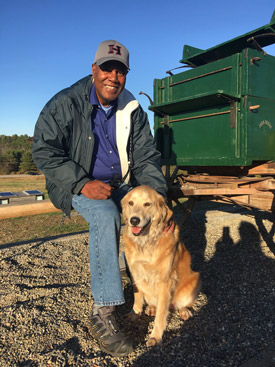
Living on Earth Host Steve Curwood and his family’s dog Jilly. (Photo: Jennifer Stevens-Curwood)
FALL: So, we found that owners to pointing dogs, such as pointer or German short-haired pointer as an example, and retriever dogs, such as the golden retriever or Labrador retriever, they have the lowest risk of cardiovascular disease. It could also be that people that are already physical active, and they like to be outdoors, they get one of those breeds instead of a more, you know, Chihuahua or some more toy breed.
CURWOOD: So, Tove, what would be the take home message from your study? What should people take away from this?
FALL: So, in general in Sweden I would say that dog owners live longer, and I would say also in single households dog owners have lower risk of cardiovascular hospitalization compared to non-single non-owners. So, I would say that I think it's important for doctors and the general society to also to acknowledge that pets can be very important for their owners, and you shouldn't think that, if someone tells you their pet passed away, it could be a very big thing for them, especially if they're single. So, that could be a big bereavement.
And we're actually studying that right now, what happens close to the animal’s death, what happens with the owner’s immediate cardiovascular risk. We know that if your partner passes away, then you have increased risk of cardiovascular hospitalization and death, and we'll now look into that also for pets. So, that will be very interesting to see.
CURWOOD: Yeah, that seems to be a little bit of a secret among pet owners that when their beloved dog dies, they may be far more bereaved that they are when, you know, Cousin Albert dies.
FALL: Yes, I heard many of those stories, actually. I think the relationship with your dog or cat is usually very uncomplicated. With people it's much more complicated and complex, but with a dog it's so simple. They get happy when they see you. They don't blame you for things. They're just like they are, you know? So they're easy to love.
CURWOOD: Tove Fall is an Associate Professor of Epidemiology at Uppsala University in Sweden. Thank you so much, Professor, for taking the time today.
FALL: OK. Thank you.
Related link:
The study in Nature: “Dog ownership and the risk of cardiovascular disease and death – a nationwide cohort study”
[MUSIC: Erich Kunzel/Rochester Pops/William Tritt, piano, “New World A Comin’” on Ties & Tails, composed by Duke Ellington, Pro Arte Digital]
CURWOOD: Coming up, the emotional lives of fish are surprisingly close to our own. That’s just ahead here on Living on Earth. Stay tuned.
ANNOUNCER: Funding for Living on Earth comes from you our listeners, and United Technologies, combining passion for science with engineering to create solutions designed for sustainability in aerospace, building industries and food refrigeration. UTC companies such as Otis, Carrier, Pratt & Whitney and UTC Aerospace Systems are helping to move the world forward. You can learn more about United Technologies by tuning in to the Race to 9 Billion podcast, hosted by UTC’s Chief Sustainability Officer. Listen at raceto9billion.com. That’s raceto9billion.com. This is PRI, Public Radio International.
[CUTAWAY MUSIC: Erich Kunzel/Rochester Pops/William Tritt, piano, “New World A Comin’” on Ties & Tails, composed by Duke Ellington, Pro Arte Digital]
The Inner Lives of Fish
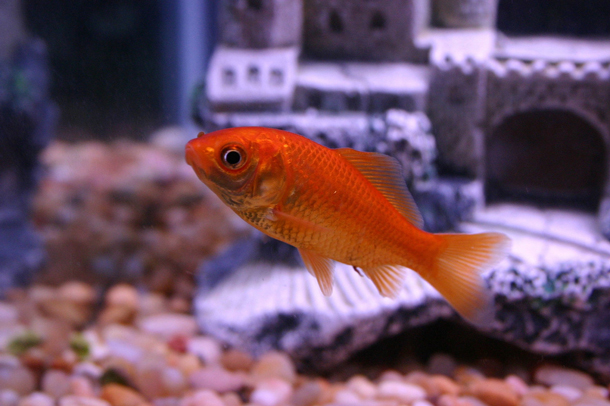
Fish are smarter than you might think – and they can get depressed like people. (Photo: Kai Schreiber, Flickr CC BY-SA 2.0)
CURWOOD It’s Living on Earth, I’m Steve Curwood.
In the Disney Pixar film “Finding Nemo,” when little Nemo is caught and taken to a fish tank in a Sydney dentist’s office, he meets a fish named Gill, who dreams only of making it out to the Big Ocean.]
[AUDIO FROM “FINDING NEMO”]
GILL: My first escape, landed on dental tools. I was aimin’ for the toilet.
NEMO: Toilet?
GILL: All drains lead to the ocean, kid.
NEMO: Wow. How many times have you tried to get out?
GILL: Ah, I’ve lost count. Fish aren’t meant to be in a box, kid. It does things to ya’.
[SOUND OF BUBBLES]
OTHER FISH: BUBBLES!! BUBBLES, BUBBLES.
CURWOOD: Well, “Finding Nemo” may not be so far-fetched, as scientists claim that fish brains are complex and really quite like ours. In fact, human antidepressant medications are being tested on zebra fish.
Culum Brown teaches Sat Macquarie University in Australia and studies fish cognition. He joins me now from Sydney. Welcome to Living on Earth.
BROWN: Ahh, thank you. It's great to be here.
CURWOOD: So, why do species like the Zebrafish make good models for humans and testing new anti-depressant medications?
BROWN: Yeah, so I guess the first thing that the whole pharmaceutical companies caught onto was the fact that waste pharmaceuticals, after we've used them... Obviously we take medicine, we don't fully metabolize all the medicines we take. Most of them end up going down our sewerage system, and our modern sewerage plants just aren't set up to deal with pharmaceuticals, and probably 10 or so years ago people started recording high levels of all sorts of pharmaceuticals in runoff and indeed in things like Sydney Harbor and some of the major ports. And then it became pretty apparent that those things were having effects on the behavior of the animals living in those environments, including the fish. The genetic components and the underlying physiology, neurotransmitters, and all those sorts of things, are highly conserved across all vertebrates, so everything from fish to humans basically have a shared physiology.

Pharmaceuticals such as antidepressants often end up downstream of water treatment plants, which can’t remove them, and have been found to change fish behavior in places like Sydney Harbour. (Photo: Bernard Spragg. NZ, Flickr Public Domain)
That means that all those antidepressants that are specifically designed to manipulate human behavior also manipulate fish behavior in very similar ways. That's really how it started, and then of course the pharmaceutical companies soon realized that, well, “Why are we spending all this money on rats? You know, for every rat we have in an animal house somewhere we could have 50 Zebrafish,” and so they basically shifted their models system from rats to studying Zebrafish. And Zebrafish for a long time have been used in captivity because we can manipulate the genes and breed all sorts of different mutant lines of Zebrafish. They're a really fascinating model system.
CURWOOD: So, how do you test the anti-depressant in the Zebrafish? I mean, how do you know they're depressed to begin with?
BROWN: Well, of course, the first thing you need to know about recognizing depression is that you have to know what normal behavior looks like in animals and indeed in humans. When you are looking for signs of depression, they're actually very similar. The fish tends not to engage with the outside world and they tend to sort of mope around in the corner. Their activity levels tend to go down and all those sorts of things. And then, of course, you dose them, and you dose them at specific rates and various therapeutical levels. Their behavior starts to change.
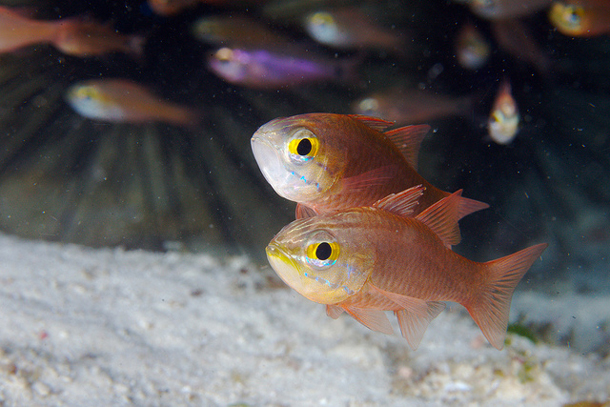
Many fish are social creatures, living in schools together and learning essential behaviors from one another. (Photo: Klaus Stiefel, Flickr CC BY-NC 2.0)
And if you look at something like an antidepressant, what it tends to do is it dulls anxiety and excitement but it does it in both ways, so the fish never get really excited when they should. So, for example if you have two males that might be ordinarily highly aggressive when they see each other, they tend not to be as aggressive. And similarly if fish are exposed to something that might be scary or terrifying for them, some sort of shock or something like that or a predator, they also tend to have very limited response to predators and those sorts of situations as well. So, it tends to produce a very even behavior, very boring. They don't really respond to external cues in the way that they should.
CURWOOD: So, what kind of research have you done on fish cognition?
BROWN: So, my background really is, it started off as looking at predator recognition and avoidance responses. I was very much interested in conservation biology and restoring natural populations in the wild, and there are many examples where animals are moved around the environment, and for example, predators move from one habitat to another, and they tend to wipe out all sorts of local native species, and that happens in fish a lot. And I was looking at how we can use learning and memory to retrain them to recognize predators, with the hope of releasing effectively smart fish back into the wild to cope with predators, and that was during my honors in PhD a long time ago, 20 years ago, and I've been studying all sorts of aspects of intelligence in fish, since.
CURWOOD: Culum, how do people respond when you told them that, well, you kind of study the psychology of fish.
BROWN: [LAUGHS] Yes, so there are all sorts of cartoons of me having a fish on the couch in my office and asking questions like, "How does that make you feel?"

A black grouper and green moray eel engage in cooperative hunting. (Photo: Andy Blackledge, Flickr CC BY 2.0)
CURWOOD: So, to what extent do fish have societies? I'm told that Groupers especially seem to be social.
BROWN: Yes, I think people forget about just how social fish can be, and there's this theory that tries to explain why humans are as smart as they are, and it has to do with social intelligence. It's called the Social Intelligence Hypothesis, and it was originally coined to explain why humans, and indeed primates, are smart, and the idea is that you have these complex social interactions, you need to be fairly brainy to keep track of all those interactions, you know, who's the boss and who's not, and who's interacting with who, and all those sorts of things.
But, you know, humans and primates aren’t the only ones that spend a lot of time in social groups, and obviously flocks of birds are pretty well known, and indeed schools of fish are a pretty standard issue. If you're thinking about fish, you often think of a school of fish. So, fish are very social.
Many species have highly complex social interaction,s and it happens not just within species, but it can also happen between species, and this is some really nice work looking at Groupers interacting with Moray eels and soliciting joint foraging trips out into the coral reef and the Grouper goes across the surface of the coral reef and the eel moves between the spaces of the coral reef, and between the two of them there's really no place for the prey to hide.
CURWOOD: [CHUCKLES] I imagine the eel can go down into the little crevice and then spook whatever's hiding in there, and then [MAKES THE SOUND OF QUICKLY SLURPING UP FOOD.] the Grouper has it.
BROWN: Right, and the same thing happens is the Grouper is cruising along the top, all the fish duck down into the coral to hide and, well, straight into the path of the of the eels. So, when they work together, synergistically the outcomes for both of them is much higher than if they're just working by themselves.
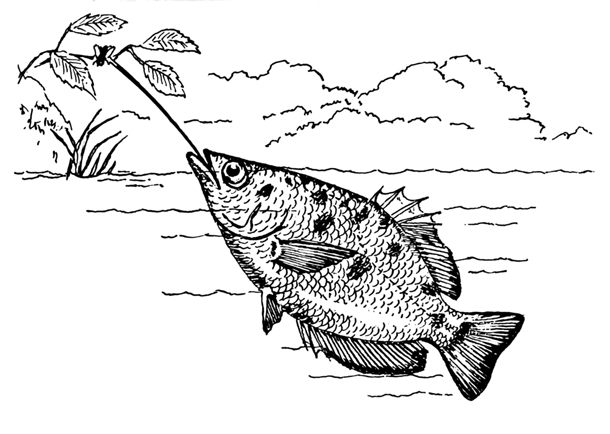
A diagram of an archerfish shooting a jet of water at an insect to capture it when it falls. (Photo: Pearson Scott Foresman, Wikimedia Foundation creative commons)
CURWOOD: So, how do they do high five? One fin to a...
BROWN:[LAUGHS] Possibly. They certainly do some weird body shakes and various things to communicate to each other.
CURWOOD: So, talk to me about some examples, some more examples of what's going on that meets the eye when it comes to some species of fish.
BROWN: Yeah, so, I mean we just talked about social intelligence, and just like you and I, if a fish gets a choice between an unknown fish on one side and perhaps a group of known fish on the other, they will nearly always choose to hang out with the fish that is familiar with them. So, just like if we go to a party, we don't usually hang out with a bunch of strangers, when we tend to gravitate towards the people we know and interact with them. And fish will do the same thing. They can recognize themselves and other individuals.
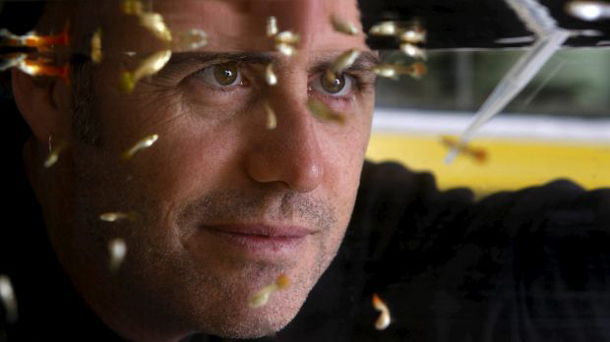
Culum Brown studying guppies. (Photo: courtesy of Culum Brown)
And one of the species we work in is an Intertidal Gobi, and it's found in the same rock pool week after week after week. And if you pick them up and move them 50 or 100 meters down the rock platform, they come back the next day. So, they have really amazing homing capabilities, and the shark species that we work on migrate, you know, 1,500 kilometers or more and come back to exactly the same reef every year, year after year after year.
Of course, there are lots of other components of cognition that we study, and you know I've recently written a review on tool use in fishes which again was one of those things that we used to think was unique to people, but the more we learn about it, the more we find that there are fishy examples.
CURWOOD: Wait a second. You're talking about fish using tools? What kinds of tools do fish use?
BROWN: [LAUGHS] Yeah, so, one of the problems with the definition of tool use, of course, is this was actually originally coined to explain tool use in primates. Of course, primates are very similar to humans. And primates and humans tend to use their hands to manipulate tools. Of course, fish don't have hands, but what they do have are the aspects of the environment that they can use. They're very well known for manipulating water, for example, so Archerfish can basically generate a water pistol that they sit at the surface of the water, and they shoot insects above the surface of the water, and the insects fall to the surface of the water and they grab them as they fall down, and their marksman skills are second to none. It's just incredible, and that's not something they do automatically. It's something they have to learn as they grow and develop so their skills improve.

A goby swims through a maze designed to test spatial learning skills. (Photo: courtesy of Culum Brown)
CURWOOD: OK, Culum, how should we be treating fish to provide for their mental health needs?
BROWN: You know, for a long time in many zoos around the world, the old school zoo was basically a concrete pen in which the animal was placed, and it soon became apparent that the animals started doing unusual behaviors. They certainly weren't behaving normally. They would do things like, you know, pace around the enclosure, rock back and forth and all those sorts of things. And it soon became apparent that that was a response to a lack of environmental enrichment. There was nothing for them to respond to or react to or, and so their behavior becomes abnormal in captivity.
And so zoos, particularly in the last 10 to 15 years, really started to concentrate on making the enclosures more like the real world. They planned it out. They start introducing little caches of food around the place so the animal actually has to forage and find food and things like that, and that sort of enrichment has a really big impact on the behavior of the animal in captivity. And it's really only maybe the last 10 years I suppose that we started thinking about exactly the same approach but in fishes, that if you increase the complexity of the environment that these animals are living in, there are all sorts of benefits in terms of regenerating natural behaviors.
And in fact, not only is their behavior returning to normal and becoming more sophisticated, their brain is remodeled as well. Their brain has more connections, it tends to get bigger, and so that's the sort of thing we like to see. It's great from an animal welfare perspective, but it also has really positive conservation biology outcomes because many fish around the world are reared in captivity and then released into the wild to try and bolster natural populations, and of course if you don't have that kind of enrichment when they're reared then their behavior when they're released is completely wrong, and they die really quickly.
CURWOOD: So, somebody listening to us who has an aquarium at home and cares a lot about the fish. What can they do to make the fish feel happier?
BROWN: Yeah, of course fishes are in fact the most numerous pet in the world, so in terms of the numbers of pets, fish are by far and away more popular than cats and dogs and anything else. So, much the same way you wouldn't keep your dog in a boring cupboard, or your cat for that matter, you shouldn't really keep the fish in an empty, boring aquarium or a goldfish bowl. In fact, in some countries around the world, goldfish bowls are banned for animal welfare reasons.
Really, what you want is a reasonable size volume of water to start with. If you don't have a good volume of water, then just maintaining water chemistry becomes more difficult. But also, in terms of the space for the animals to move around, you really want the animal to be active just in the same way that you see an enclosure in a zoo. It's got lots of physical structure for the animal to interact with. If you can feed the animal live foods and things like that, then that obviously is a great thing. And even hide bits of food in the aquarium, move things around, occasionally introduce a new rock or a new plant or something just to keep it interesting, but the main thing is to keep it complex, both socially and physically.

In Port Jackson, which includes Sydney Harbour, Culum Brown and his team study shark social networks and long distance migration. (Photo: courtesy of Culum Brown)
So there are a number of fish as we mentioned earlier that are social, and they won't do very well by themselves and so you might be better off buying two or three or four of a single species so they can interact and have social interactions and meaningful interactions. All these sorts of things will increase the complexity of their lives, and it will just make your aquarium look better and the fish more interesting to watch.
CURWOOD: Culum Brown is an Associate Professor at Macquarie University in Sydney, Australia, where he leads its fish lab. Thank you so much for taking the time with us today.
BROWN: It’s been a pleasure.
Related links:
- The Behaviour, Ecology and Evolution of Fishes Laboratory at Macquarie University
- NYTimes: “Fish Depression Is Not a Joke”
- About Culum Brown
[MUSIC: Richard Stoltzman, Viderunt Omnes, on New York Counterpoint, composed by Perotin/arr.Stolzman, RCA Red Seal]
A Dinner for Fish

The Sea of Cortez covers thousands of square miles between Baja California and the rest of continental Mexico. This vast expanse is teeming with fish, including Wahoo. (Photo: Flickr CC BY-SA 2.0)
CURWOOD: Apart from the risk of depression, fish are also capable of sophisticated strategy. At least, that’s how our Explorer in Residence, Mark Seth Lender, understood an encounter he had in the Sea of Cortez east of Baja, California.
LENDER: Flat on your belly outside of the sight of land, supported by a bottomless pit of water, the Sea of Cortez does not feel like anyone’s friend. Everything else probably knows this. Or that’s how it seems. I don’t see any life below me. And wonder why there isn’t. All the sparkling stuff of the sea they tell you about must be… on vacation, in some other part. Or maybe for the bright little fishes it is just too far from shore. Who can blame them? It is… unsavory. So much emptiness and to be all alone.
And then, I am not.
They are the shape of spears. Long and thin. Like barracuda, but bigger. Much bigger, than any barracuda I’ve ever seen. Tail fins built in an ancient and symmetrical, vertical way. Mouths toothy as a saw, and that same shape, even and long. Their eyes capable of rolling around to watch, as they cut a close circle, of me. One they could cross - all three of them - in less than the time it takes to fill your lungs.You wouldn’t have time to scream. And who would hear you if you did? They are perfectly spaced. Almost as tall as I am if you stood one on end. There would be no escape.

A pair of wahoo lay next to a yellow mahi mahi and a much smaller barracuda. Wahoo can grow to 6 feet in length. (Photo: Flickr CC BY-SA 2.0)
But I can feel the thought they’re thinking. I’ve felt it, from hawks who look you up and down so quick it’s over before you know what’s happening. And the verdict of these three Wahoo, cruising, like hawks of the sea? It’s the same as before, when sized up… by those hawks… of the air: Too Big. This judgment having precluded the further discourse of Edible or Inedible.
On their way back the Wahoo circle me once more. Just to be sure.
CURWOOD: That’s our Resident Explorer, mark Seth Lender, and there’s more at our web-site, LOE dot org.
Related link:
Mark Seth Lender’s photography and writings
[MUSIC: Art Blakey, “I’ve Got My Love To Keep Me Warm” on Drums Around the Corner, composed by Irving Berlin, Blue Note Records]
CURWOOD: Living on Earth is produced by the World Media Foundation. Our crew includes Naomi Arenberg, Bobby Bascomb, Savannah Christiansen, Jenni Doering, Noble Ingram, Jaime Kaiser, Don Lyman, Helen Palmer, Adelaide Chen, and Jolanda Omari. Tom Tiger engineered our show, with help from John Jessoe and Jake Rego. Alison Lirish Dean composed our themes. You can hear us anytime at LOE.org -- and like us, please, on our Facebook page - PRI’s Living on Earth. And we tweet from @LivingonEarth. I'm Steve Curwood. Thanks for listening.
ANNOUNCER1: Funding for Living on Earth comes you, our listeners, and from the University of Massachusetts, Boston, in association with its School for the Environment, developing the next generation of environmental leaders. And from the Grantham Foundation for the protection of the environment, supporting strategic communications and collaboration in solving the world’s most pressing environmental problems. Support also comes from the Energy Foundation, serving the public interest by helping to build a strong, clean, energy economy, from Carl and Judy Ferenbach of Boston, Massachusetts and from
SolarCity, America’s solar power provider. SolarCity is dedicated to revolutionizing the way energy is delivered by giving customers a renewable alternative to fossil fuels. Information at 888-997-1703. That’s 888-997-1703.
ANNOUNCER2: PRI. Public Radio International.
Living on Earth wants to hear from you!
Living on Earth
62 Calef Highway, Suite 212
Lee, NH 03861
Telephone: 617-287-4121
E-mail: comments@loe.org
Newsletter [Click here]
Donate to Living on Earth!
Living on Earth is an independent media program and relies entirely on contributions from listeners and institutions supporting public service. Please donate now to preserve an independent environmental voice.
NewsletterLiving on Earth offers a weekly delivery of the show's rundown to your mailbox. Sign up for our newsletter today!
 Sailors For The Sea: Be the change you want to sea.
Sailors For The Sea: Be the change you want to sea.
 The Grantham Foundation for the Protection of the Environment: Committed to protecting and improving the health of the global environment.
The Grantham Foundation for the Protection of the Environment: Committed to protecting and improving the health of the global environment.
 Contribute to Living on Earth and receive, as our gift to you, an archival print of one of Mark Seth Lender's extraordinary wildlife photographs. Follow the link to see Mark's current collection of photographs.
Contribute to Living on Earth and receive, as our gift to you, an archival print of one of Mark Seth Lender's extraordinary wildlife photographs. Follow the link to see Mark's current collection of photographs.
 Buy a signed copy of Mark Seth Lender's book Smeagull the Seagull & support Living on Earth
Buy a signed copy of Mark Seth Lender's book Smeagull the Seagull & support Living on Earth

